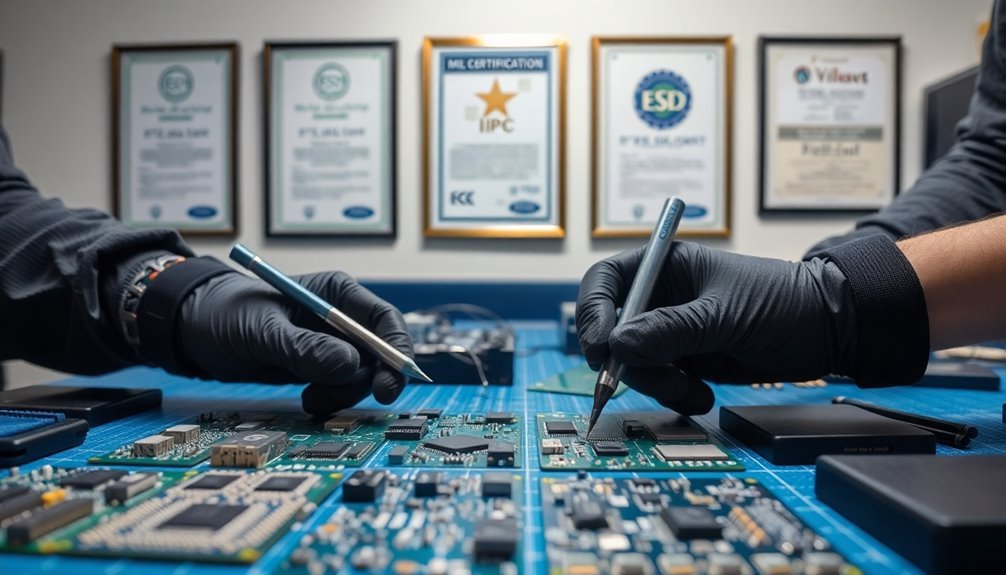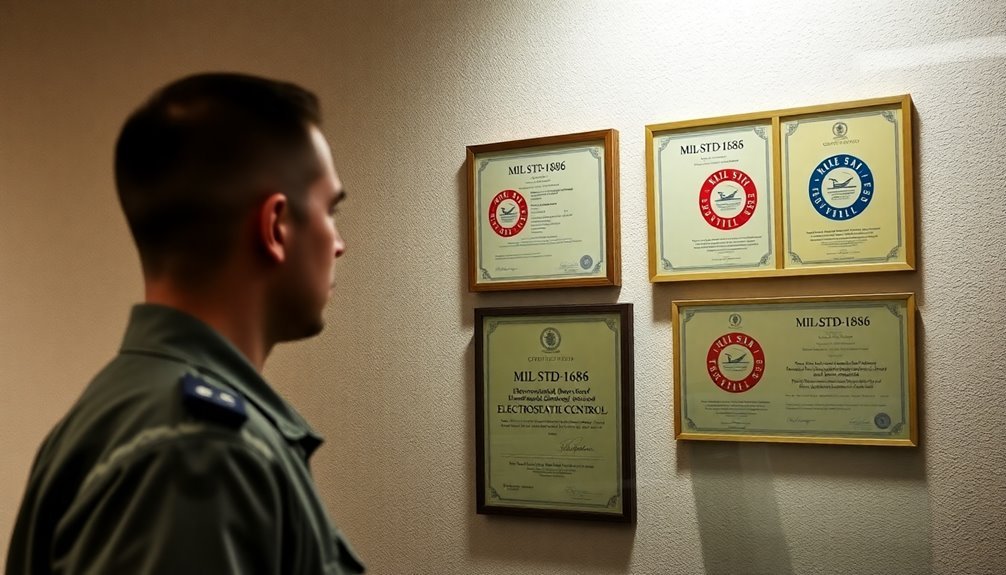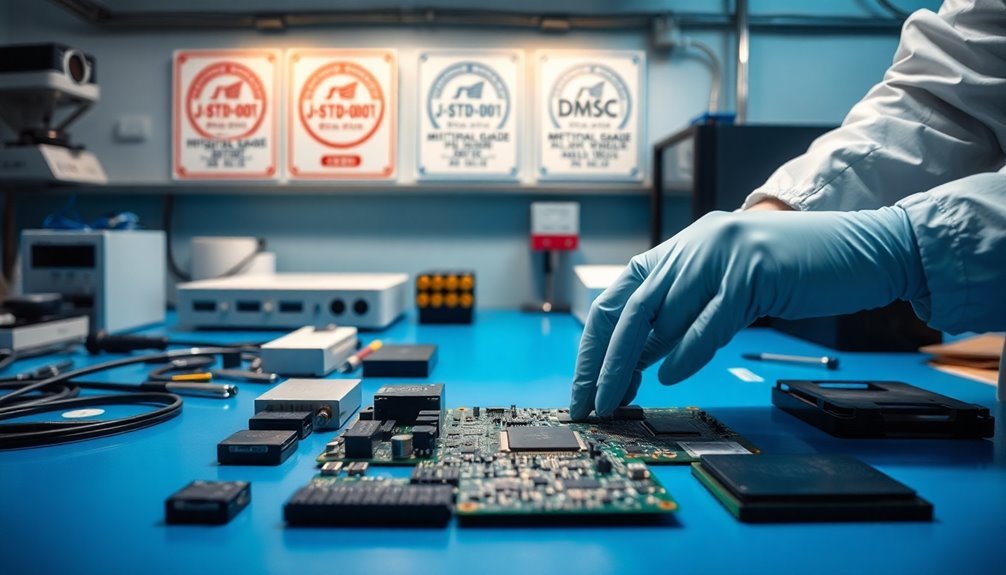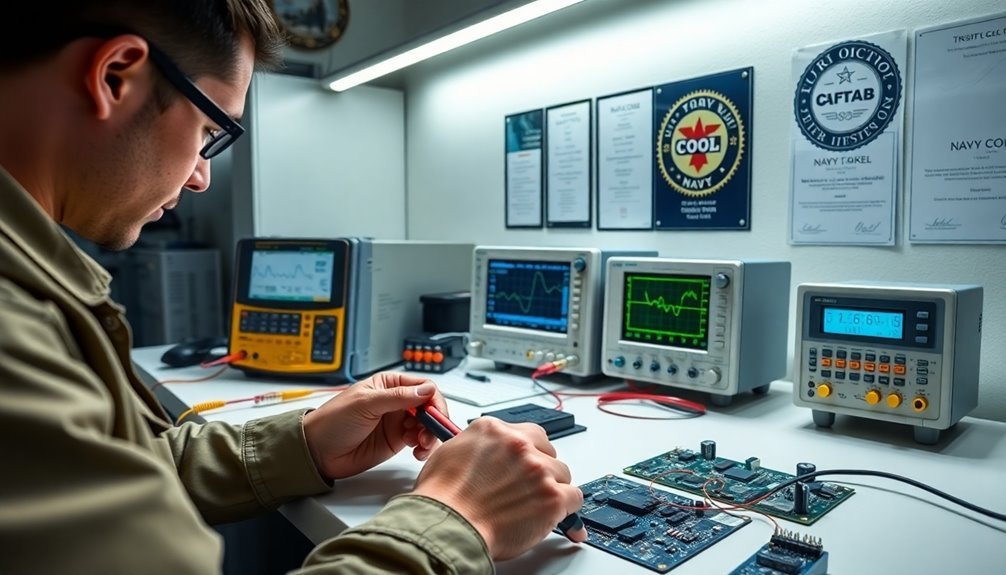The top military electrical discharge certifications you'll want to pursue include the iNARTE EMC Specialist certification, which is highly respected across defense industries. You'll also benefit from getting certified in MIL-STD-1686 compliance and ANSI/ESD S20.20 standards, both essential for military contractors. The Naval ESD Protection certification is vital if you're working with ordnance or sensitive equipment. Round out your credentials with NFPA 70E electrical safety certification, required for workplace safety compliance. These certifications will strengthen your expertise in protecting critical military components, and there's much more to explore about each program's specific requirements and advantages.
Understanding Military ESD Certifications

Military Electrical Discharge (ESD) certifications systematically establish the standards and qualifications needed to protect sensitive electronic equipment in military operations. These certifications are structured across five distinct levels, each building upon the previous one's requirements and responsibilities.
The foundational certification begins with MIL-STD-1686, which outlines basic ESD control program requirements. As you progress, you'll encounter MIL-HDBK-263, providing extensive guidelines for protecting electrical and electronic components. The transition from military to commercial ESD standards has enhanced the broader applicability of these certifications.
The role of ESD Technical Agent represents a higher level of expertise, where you'll evaluate ESD susceptibility in ordnance and verify compliance with safety standards.
NOSSA certification serves as the official authority for ESD compliance, and you'll need to demonstrate thorough knowledge of DOD Safety Engineering Requirements. To maintain your certification, you must complete specific training programs, gain practical experience, and secure official certification from NOSSA.
You'll also need to stay current through periodic renewals.
These certifications aren't just about compliance – they're essential for enhancing equipment reliability, improving system security, and advancing your military career. By pursuing these certifications, you'll develop specialized expertise that's vital for protecting military electronic assets.
Inarte EMC Specialist Program
Three key features define the iNARTE Military Standard EMC Specialist certification: rigorous education requirements, substantial work experience, and thorough examination standards. You'll need more than two years of post-high school education and equivalent work experience to qualify for this advanced certification. Military service members can take advantage of free certification application with proof of service.
The certification's four-hour open-book examination requires a 70% passing score, and you can use a scientific calculator during the test. If you don't pass, you'll need to wait 90 days before retaking it.
To help you prepare, LearnEMC offers extensive study materials, including 200 printed sample problems and 60 video tutorials.
What makes this certification valuable is its professional recognition and career advancement potential. You'll establish yourself as a top performer in the industry, measured against international standards. The certification's particularly useful if you need to provide expert testimony in court cases. Additionally, it can be added as an endorsement to an existing iNARTE EMC Certification.
Unlike many other certifications, it doesn't require continuing education units or professional development for renewal, making it a long-term investment in your career.
MIL-STD-1686 Certification Requirements

The MIL-STD-1686 certification establishes strict requirements for protecting electronic components from electrostatic discharge (ESD) damage. To earn this certification, you'll need to demonstrate thorough knowledge of ESD control program requirements and their implementation across manufacturing, processing, assembly, and handling operations.
You'll need to understand how to classify electronic components using three key models: Human Body Model (HBM), Machine Model (MM), and Charged Device Model (CDM). Each model has specific voltage classifications you must master, from basic sensitivity levels to high-voltage tolerances. The standard specifically requires quality assurance reviews and audits as part of maintaining certification compliance.
As a certified professional, you'll be expected to know how to establish and document an ESD control program that includes both administrative and technical requirements.
This includes implementing proper training protocols, designing protected areas, and developing handling procedures. You'll also need to understand how these requirements extend to suppliers and subcontractors.
The certification requires you to demonstrate expertise in compliance verification methods and documentation practices. You must know how to determine the lowest safe ESD sensitivity levels for handling components and implement appropriate quality assurance measures to maintain program effectiveness.
Naval ESD Protection Standards
Naval ESD protection standards have evolved substantially since their inception, with ANSI/ESD S20.20 now superseding the longstanding MIL-STD-1686C as of 2021.
You'll need to understand the three main sensitivity classifications: Human Body Model (HBM), Machine Model (MM), and Charged Device Model (CDM), as they're vital for proper device protection. The increasing complexity of modern electronics has made robust ESD controls more critical than ever before.
When you're working with ESD-sensitive components, you'll need to establish protected areas that minimize electrostatic voltages and charges. You must guarantee all sensitive devices are fully enclosed in protective materials during transport unless you can effectively mitigate the risks.
If you're handling components in unprotected areas, you'll need to implement alternative precautions and procedures.
The standards you'll follow aren't just for military applications – many civilian companies have adopted these practices for high-reliability environments. You can integrate these ESD control programs with ISO 9001 quality management systems, making them more thorough.
Remember that NOSSA provides technical oversight for ESD testing in naval ordnance, while JOTP serves as interim test procedures until they're incorporated into future Military Standard revisions.
Military Component Handling Certification

When you're working with military electronic components, you'll need specific certifications that cover both HAZMAT and ESD safety protocols.
Your training must include proper handling techniques for ESD-sensitive parts, following 49 CFR regulations and DoD Component requirements for material transport and storage. Personnel must complete the required foundational qualifications within 9 months of assignment according to DoD 8140 standards.
You'll need to maintain documentation of your certifications, including DD Form 2781 for container handling and evidence of completed mandatory training in accordance with military standards.
Component Safety Training Requirements
Operating within military environments demands rigorous adherence to component safety training requirements, particularly when handling sensitive electrical equipment.
You'll need to master thorough training programs that align with both 29 CFR 1910 Subpart S standards and military-specific protocols.
Your certification journey must cover hazardous location operations under 29 CFR 1910.307, special systems outlined in 29 CFR 1910.308, and proper use of electrical protective devices per 29 CFR 1910.137.
You're required to demonstrate proficiency in work practices (29 CFR 1910.333), equipment handling (29 CFR 1910.334), and personnel protection measures (29 CFR 1910.335).
You'll find that training programs emphasize standardized, repeatable processes taught by certified instructors. Understanding three-phase AC power systems is crucial for working with large-scale military installations.
You must complete regular evaluations to maintain your certification, and you'll need to stay current with evolving standards through continuous professional development.
If you're handling hazardous materials, you'll require additional specialized training that covers transportation regulations and safety protocols.
Don't forget that your training must also incorporate NFPA 70E standards and follow U.S. Army Corps of Engineers Safety & Health Requirements Manual guidelines for complete compliance.
ESD Sensitive Parts Management
The successful management of ESD-sensitive components requires strict adherence to MIL-STD-1686 and ANSI/ESD S20.20 standards.
You'll need to identify ESD-sensitive items through specific classifications like FSC 5955, FSC 5963, and FSC 7042, which are designated by the US Army Missile Command as requiring special handling. Common activities can generate static charges up to 35,000 volts that may permanently damage sensitive military equipment.
Proper preservation of these components demands ESD/EMI protective packaging materials that meet MIL-PRF-81705 specifications. When you're handling these items, you must use properly designed workstations with adequate grounding to a mass capable of accepting large electrical charges, such as earth or a vehicle hull.
To guarantee compliance, you'll need to follow MIL-PRF-19500 documentation for ESD classifications and part number identification. You must also apply proper labeling according to MIL-STD-129, using MOP "GX" and Special Marking Code "39" to indicate ESD susceptibility.
When transporting these components, you're required to maintain documentation using DD Form 2781 and DD Form 2890 for HAZMAT certification, while following AFMAN 24-604 guidelines for military air shipments.
Defense Industry ESD Programs
Military ESD control programs must follow strict standards like MIL-STD-1686, which outlines protection requirements for electrical and electronic components across U.S. military agencies and contractors.
You'll need qualified personnel with certifications such as iNARTE Aerospace & Defense Engineer or NOSSA certification to effectively manage these programs. Hands-on instrument training is required as part of the certification process to ensure proper ESD troubleshooting capabilities.
Your ESD control team should include trained technical agents who can evaluate data, maintain databases, and verify compliance with both military and NASA standards.
Essential ESD Control Standards
Within defense industry operations, Electrostatic Discharge (ESD) control standards serve as critical guidelines for protecting sensitive electronic components and equipment. You'll need to familiarize yourself with key standards like MIL-STD-1686, which establishes fundamental requirements for ESD control programs in military applications, and ANSI/ESD S20.20, its commercial successor.
| Standard Type | Key Requirements |
|---|---|
| Military | MIL-STD-1686 for defense electronics protection |
| Commercial | ANSI/ESD S20.20 for broad industry application |
| International | IEC 61340-5-1 for manufacturing environments |
| Semiconductor | JESD625B for specialized component handling |
| Quality Management | ISO 9001 integration with ESD controls |
To maintain compliance, you'll need certification through recognized programs like iNARTE Space and Defense ESD Program Monitor Certification or ESDA training. These certifications validate your understanding of critical standards and demonstrate your ability to implement effective ESD control measures. Remember that different sectors of the defense industry may require specific standards – for instance, semiconductor manufacturing facilities must adhere to JESD625B, while general electronics assembly might focus more on MIL-STD-1686 requirements.
ESD Program Personnel Requirements
Building upon established ESD control standards, effective personnel requirements form the backbone of any successful defense industry ESD program. You'll need to understand both MIL-STD-1686 and ANSI/ESD S20.20 standards, which govern ESD control across manufacturing, processing, assembly, and other critical operations.
These requirements guarantee you're properly trained and certified to handle sensitive electronic components.
To excel in military ESD programs, you should focus on these essential areas:
- Extensive training in ESD fundamentals and control principles
- Regular certification maintenance through continuing education
- Practical hands-on experience with ESD-sensitive components
- Documentation and compliance with audit requirements
- Implementation of established ESD control procedures
The iNARTE certification stands out as a valuable credential if you're pursuing a career in ESD engineering. You'll need to pass a thorough examination to demonstrate your technical competency, and you must maintain your certification through ongoing professional development.
Whether you're a current service member or veteran, this certification can enhance your expertise in ESD control measures and open doors across both government and private sector positions.
Certification Maintenance and Advancement
Once you've earned your electrical discharge certification, maintaining and advancing it requires ongoing commitment. Unlike one-time certificates, these certifications need periodic renewal through continued professional development and testing to verify you're up-to-date with current standards like MIL-STD-1686 and NETA requirements.
You'll need to regularly test and maintain your electrical equipment, verifying it's properly labeled with accurate arc flash information. If you're in the military, you can take advantage of the U.S. Army's credentialing assistance programs to help cover maintenance costs. Veterans can also use GI Bill benefits for certification exam fees.
To advance your career, consider pursuing additional specialized certifications like CCMP, which focuses on professionalizing the intelligence workforce.
You'll find that ESD certifications are particularly valuable when working with static-sensitive devices and evaluating personnel-borne and helicopter-borne ESD risks. Keep in mind that while certifications aren't legally required like licenses, they're highly regarded in the industry and can substantially boost your career prospects.
Following NCCA Standards verifies your certification program meets modern practice standards, making you more marketable in the field.
Frequently Asked Questions
Can Military Electrical Discharge Certifications Be Transferred to Civilian Job Roles?
Yes, you can transfer your military electrical discharge certifications to civilian jobs through USMAP and DOL programs, but you'll need to document your skills and may require additional training for full certification equivalency.
What Is the Average Cost Range for Obtaining These Certifications?
You'll find certification costs vary widely: free for active/former military with service proof, while general programs range from $1,485 to $5,942. The GI Bill can reimburse up to $2,000 per exam.
Are There Online Training Options Available for These Certification Programs?
You'll find limited online training options through iNARTE's EMC certification program. While some theory can be learned remotely, hands-on components typically require in-person training. Virtual classrooms are available for certain theoretical modules.
How Long Does It Typically Take to Complete Each Certification?
You'll typically need 3-6 months to complete electrical discharge certifications, depending on your study pace. The iNARTE MIL-STD EMC Specialist program can be faster if you've got relevant military experience.
Can International Military Personnel Apply for These Us-Based Certifications?
You'll need to apply through established programs like IMET or BPC. While some certifications are available, you must meet security requirements and have your government's sponsorship to participate in U.S.-based certification programs.
In Summary
Military electrical discharge certifications are essential tools you'll need to advance your defense industry career. Whether you're pursuing the Inarte EMC Specialist Program or MIL-STD-1686 certification, staying current with recertification requirements is vital. Don't overlook the value these credentials add to your expertise. By maintaining and upgrading your ESD certifications, you'll remain competitive and qualified for specialized military contracts.





Leave a Reply